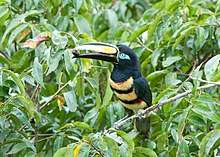Many-banded aracari
The many-banded aracari, or many-banded araçari (Pteroglossus pluricinctus), is a species of bird in the family Ramphastidae.[2][3]
| Many-banded aracari | |
|---|---|
 | |
| Scientific classification | |
| Kingdom: | Animalia |
| Phylum: | Chordata |
| Class: | Aves |
| Order: | Piciformes |
| Family: | Ramphastidae |
| Genus: | Pteroglossus |
| Species: | P. pluricinctus |
| Binomial name | |
| Pteroglossus pluricinctus Gould, 1835 | |
It is found in Brazil, Colombia, Ecuador, Peru, and Venezuela. Its natural habitat is subtropical or tropical moist lowland forests.[4]
Description
It measures between 40.6 and 43 cm in length.[5] The beak is between 102 and 107 mm long and is ivory yellow on the top and black on the top line of the culmen and below. It has a black head, neck and upper chest; naked blue skin around the eyes; the tops with bright green feathers; lower part of the chest and belly yellow with two horizontal bands reddish to blackish and red rump to rufa.[4]
Diet
Foraging in same species flocks, they are primarily frugivorous, with opportunistic preying on insects, small birds and bird eggs, and lizards.[6][7][8][9] They play a role in seed dispersal of fruits with a dispersion range of hundreds of meters.[10] They are likely to regurgitate seeds as opposed to digesting/excreting them to avoid ballast.[9]
References
- BirdLife International (2012). "Pteroglossus pluricinctus". IUCN Red List of Threatened Species. 2012. Retrieved 26 November 2013.CS1 maint: ref=harv (link)
- "The IUCN Red List of Threatened Species". IUCN Red List of Threatened Species. Retrieved 2019-11-26.
- Bernis, Francisco (2002). "NOMBRES EN CASTELLANO DE LAS AVES DEL MUNDO RECOMENDADOS POR LA SOCIEDAD ESPAÑOLA DE ORNITOLOGÍA" (PDF). Ardeola. 49 (1): 121–125 – via seo.org.
- Hilty, Steven L. & William L. Brown (1986) Guide to the Birds of Colombia:320, pl.20. Princeton University Press.
- Schulenberg, Thomas S. (2007) Birds of Peru: 272, pl.122. Princeton University Press
- Remsen Jr, J.V.; Hyde, Mary Ann; Chapman, Angela (1993). "The Diets of Neotropical Trogons, Motmots, Barbets and Toucans". The Condor. 95 (1): 178–92. doi:10.2307/1369399. JSTOR 1369399.
- Nadkarni, Nalini M. ; Wheelwright, Nathaniel T. (Editors). Monteverde: Ecology and Conservation of a Tropical Cloud Forest. Publisher: Oxford University Press, 2000. ISBN 978-0-19-513310-3
- Robinson, S.K. (1985). "Coloniality in the Yellow-Rumped Cacique as a Defense against Nest Predators" (PDF). Auk. 10 (3): 506–19. doi:10.1093/auk/102.3.506.
- Dennis, Andrew J.; Green, R. J.; Schupp, E. W. (2007). Seed Dispersal: Theory and Its Application in a Changing World. CABI. ISBN 978-1-84593-166-7.
- Holbrook, Kimberly M. (2011). "Home Range and Movement Patterns of Toucans: Implications for Seed Dispersal". Biotropica. 43 (3): 357–364. doi:10.1111/j.1744-7429.2010.00710.x. ISSN 1744-7429.
